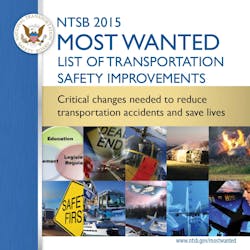Rail tank cars that carry crude oil, ethanol and other hazardous materials across the country must do it more safely. That's one of four new issues on the NTSB's Most Wanted List for 2015.
Also new to the list of top 10 areas that need safety improvements are: Requiring that transportation operators be medically fit for duty; strengthening commercial trucking safety; and requiring pilots to strengthen procedural compliance.
“The Most Wanted List is our roadmap for 2015,” said NTSB Acting Chairman Christopher A. Hart. “We want it to be a roadmap for policy makers and legislators as well. These are safety improvements for which the time is ripe for action.”
Distraction and impairment are still key issues for the NTSB, and both are on the list again this year. According to the National Highway Traffic Safety Administration, in 2012, about one in 10 drivers in fatal crashes were distracted. In almost a third of fatal crashes, a driver was impaired by alcohol.
Also on the list this year is safety of helicopters operated by local, state, and federal governments. Pilots who fly search and rescue and law enforcement missions require safer operations. And this year the NTSB is focusing on all modes of mass transit for greater operational safety.
The board has kept an existing priority on the list and specified a date certain: Implement Positive Train Control (PTC) in 2015. The date emphasizes the deadline established by Congress in 2008 for implementation of this life-saving technology.
Most airplane crashes happen in general aviation. Last year the NTSB’s Most Wanted List prioritized identification and communication of hazardous weather in general aviation. This year, the Board is focusing on preventing loss-of-control crashes in general aviation.
‘’This list is grounded in the accident investigations by which NTSB learns safety lessons, and in the recommendations that are NTSB’s primary safety product,’’ Hart said. “At the NTSB we want to make new strides in transportation safety in 2015, and we want to lay the groundwork for years that are even safer.”
1. Disconnect from Deadly Distractions
Portable electronic devices are a cause or contributing factor in 11 accident investigations.
2. End Substance Impairment in Transportation
To be at their best, complex machinery operators should not be impaired by alcohol or drugs. There is a need for stronger laws, swifter enforcement and expanded use of technology to end substance impairment.
3. Enhance Public Helicopter Safety
These accidents can be reduced by developing and implementing safety management systems; scenario-based training; fatigue management; helicopter technology; and crash-resistant flight recorder systems for all aircraft.
4. Implement Positive Train Control in 2015
In 1969 the NTSB first recommended a forerunner to PTC. Since then, there have been deaths and injuries in accidents that PTC would have prevented.
5. Improve Rail Tank Car Safety
Accidents demonstrate that the tank cars moving flammable liquids are not up to the task.
6. Make Mass Transit Safer
Although each system has unique equipment, operating environments, and challenges, all can benefit from strengthening their organizational safety cultures.
7. Prevent Loss of Control in Flight in General Aviation
Accidents can be reduced through ongoing pilot education, flight currency, self-assesment and vigilant situational awareness in the cockpit.
8. Require medical Fitness for Duty
Medical conditions and treatments directly affect safety when they impair transportation professional's performance.
9. Strengthen Commercial Trucking Safety
Regulators need to improve their oversight of operators, drivers and vehicles.
10. Strengthen Procedural Compliance
Pilots are trained in safety procedures and they can prevent tragedies by complying with procedures every flight, every day.
View the NTSB brochure with complete information on the "Most Wanted."


